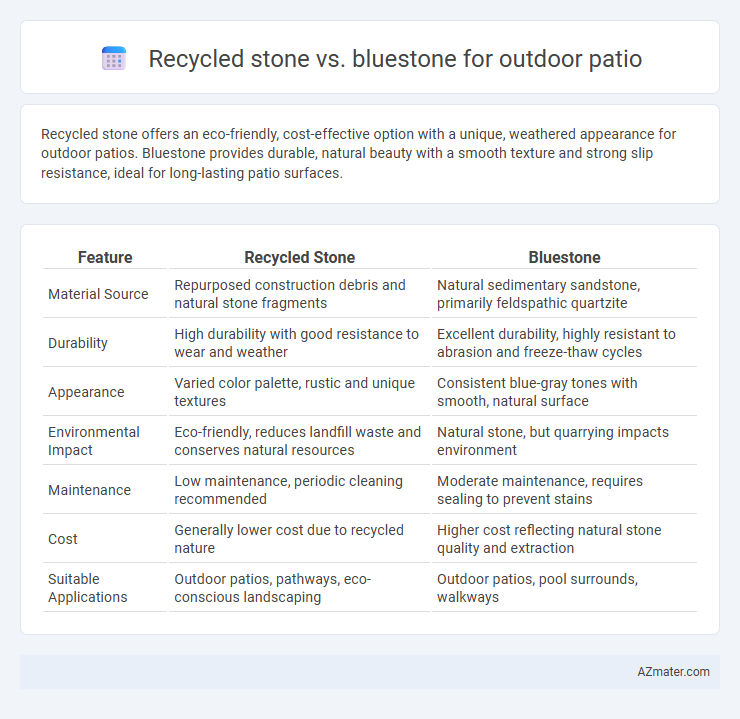Recycled stone offers an eco-friendly, cost-effective option with a unique, weathered appearance for outdoor patios. Bluestone provides durable, natural beauty with a smooth texture and strong slip resistance, ideal for long-lasting patio surfaces.
Table of Comparison
| Feature | Recycled Stone | Bluestone |
|---|---|---|
| Material Source | Repurposed construction debris and natural stone fragments | Natural sedimentary sandstone, primarily feldspathic quartzite |
| Durability | High durability with good resistance to wear and weather | Excellent durability, highly resistant to abrasion and freeze-thaw cycles |
| Appearance | Varied color palette, rustic and unique textures | Consistent blue-gray tones with smooth, natural surface |
| Environmental Impact | Eco-friendly, reduces landfill waste and conserves natural resources | Natural stone, but quarrying impacts environment |
| Maintenance | Low maintenance, periodic cleaning recommended | Moderate maintenance, requires sealing to prevent stains |
| Cost | Generally lower cost due to recycled nature | Higher cost reflecting natural stone quality and extraction |
| Suitable Applications | Outdoor patios, pathways, eco-conscious landscaping | Outdoor patios, pool surrounds, walkways |
Introduction to Recycled Stone and Bluestone Patios
Recycled stone patios, crafted from repurposed materials such as crushed concrete or reclaimed bricks, offer an eco-friendly and cost-effective outdoor flooring solution with diverse textures and color variations. Bluestone patios, made from natural sandstone quarried primarily in the northeastern United States, provide a durable and visually striking surface with a smooth, non-slip finish and earthy blue-grey hues. Both materials enhance outdoor spaces, with recycled stone emphasizing sustainability and affordability, while bluestone delivers natural elegance and long-lasting strength.
Aesthetic Appeal: Comparing Visual Styles
Recycled stone offers a rustic and eco-friendly aesthetic with varied textures and muted earth tones that blend seamlessly into natural landscapes, while bluestone provides a sleek, uniform appearance characterized by its rich blue-gray hues and smooth surface ideal for modern or traditional patio designs. Bluestone's consistent color palette enhances refined architectural styles, whereas recycled stone's irregular shapes and color variations create an organic, handcrafted look. Choosing between these materials depends on the desired visual impact, with bluestone emphasizing elegance and recycled stone highlighting sustainability and uniqueness.
Durability and Weather Resistance
Recycled stone offers moderate durability and weather resistance, making it suitable for eco-friendly outdoor patios but may show wear over time under harsh weather conditions. Bluestone, a dense and natural sandstone, provides superior durability and excellent resistance to freeze-thaw cycles, making it ideal for long-lasting patios in variable climates. Its non-porous surface reduces moisture absorption, ensuring better performance against cracking and erosion compared to recycled stone.
Cost Comparison: Initial Investment and Longevity
Recycled stone generally offers a lower initial investment compared to bluestone, making it an economical choice for budget-conscious outdoor patios. Bluestone commands a higher upfront cost due to its natural durability and aesthetic appeal, but it provides superior longevity with minimal maintenance over decades. Considering overall value, recycled stone may require more frequent repairs or replacements, whereas bluestone's durability often leads to lower long-term expenses.
Environmental Impact: Sustainability Matters
Recycled stone for outdoor patios significantly reduces landfill waste and minimizes the demand for new quarrying, lowering carbon emissions associated with stone extraction and transportation. Bluestone, while durable and aesthetically pleasing, requires extensive mining that can disrupt ecosystems and deplete natural resources. Choosing recycled stone promotes sustainability by repurposing existing materials, making it an environmentally responsible option for eco-conscious landscaping.
Installation Process and Maintenance Needs
Recycled stone patios require careful sorting and leveling during installation to ensure a stable, durable surface, while bluestone demands skilled cutting and precise placement due to its natural variability and thickness. Maintenance of recycled stone involves regular debris removal and occasional resealing to prevent erosion and weed growth, whereas bluestone needs periodic cleaning with mild detergents and resealing every few years to maintain its color and slip resistance. Both materials benefit from proper drainage planning to avoid water pooling and surface damage over time.
Slip Resistance and Safety Features
Recycled stone offers enhanced slip resistance due to its textured surface, making it a safer choice for outdoor patios in wet conditions. Bluestone, known for its natural cleft finish, provides moderate slip resistance but may require sealing to improve safety on slippery surfaces. Both materials benefit from proper installation and maintenance to optimize their anti-slip properties and overall safety features.
Customization Options and Design Flexibility
Recycled stone offers extensive customization options with a variety of colors, textures, and shapes derived from repurposed materials, making it ideal for eco-friendly outdoor patio designs. Bluestone, known for its natural blue-gray hue and uniform thickness, provides consistent design flexibility suited for classic and elegant patio layouts. Choosing between recycled stone and bluestone depends on the desired aesthetic, budget, and environmental considerations, with recycled stone favoring bespoke, sustainable projects and bluestone excelling in refined, traditional design schemes.
Availability and Sourcing Considerations
Recycled stone for outdoor patios offers high availability due to its sustainable sourcing from reclaimed materials, reducing environmental impact and often lowering costs compared to new stone. Bluestone, primarily quarried from limited regions in the northeastern United States, may have restricted availability and longer lead times, especially during high demand periods. Choosing recycled stone can provide a consistent supply with reduced carbon footprint, while bluestone's natural origin often entails region-specific sourcing challenges and potential price fluctuations.
Final Recommendations: Choosing the Right Stone for Your Patio
Recycled stone offers an eco-friendly and cost-effective option for outdoor patios, providing durability and unique character through reclaimed materials. Bluestone, known for its natural beauty, slip resistance, and weather resilience, delivers a premium aesthetic and long-lasting performance. Choose recycled stone for sustainable projects with a rustic charm, while bluestone suits those seeking a refined, classic finish with superior strength.

Infographic: Recycled stone vs Bluestone for Outdoor patio
 azmater.com
azmater.com